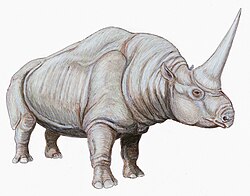| Brachypotherium Temporal range: Miocene | |
|---|---|
 | |
| Mandible | |
| Scientific classification | |
| Kingdom: | Animalia |
| Phylum: | Chordata |
| Class: | Mammalia |
| Order: | Perissodactyla |
| Family: | Rhinocerotidae |
| Subfamily: | † Aceratheriinae |
| Genus: | † Brachypotherium Roger, 1904 |
| Type species | |
| †Brachypotherium brachypus Lartet, 1848 | |
| Species | |
| |
Brachypotherium is an extinct genus of rhinocerotid that lived in Eurasia and Africa during the Miocene. [1]
Many species of Brachypotherium have been described. Some species have moved to other genera, such as B. aurelianense being transferred to Diaceratherium . [2] The genus was widespread during the Early and Middle Miocene, before heading into a decline. They went extinct in Eurasia by the beginning of the Late Miocene, with the African species B. lewisi surviving until the end of the epoch. [3]
A first upper decidual molar referable to Brachypotherium brachypus was found during gold mining in New Caledonia during the 19th century, being misidentified as a species of marsupial known as Zygomaturus. [4] However, rhinoceros were never native to New Caledonia, and the tooth likely originates from France and was probably used as jewelry by a French convict deported there. [5] [6]








